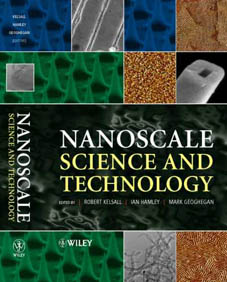It’s widely believed that, whereas the macroscopic world is governed by the intuitive and predictable rules of classical mechanics, the nanoscale world operates in an anarchy of quantum weirdness . I explained here why this view isn’t right; many changes in material behaviour at small scales have their origin in completely classical physics. But there’s another way of approaching this question, which is to ask what you would have to do to be able to see a nanoscale particle behaving in a quantum mechanical way. In fact, this needn’t be a thought experiment; Anton Zeilinger at the University of Vienna specialises in experiments about the foundations of quantum mechanics, and one of the themes of his research is in finding out how large an object he can persuade to behave quantum mechanically. In this context, the products of nanotechnology are large, not small, and among the biggest things he’s looked at are fullerene molecules – buckyballs. The results are described in this paper on the interference of C70 molecules.
What Zeilinger is looking for, as the signature of quantum mechanical behaviour, is interference. Quantum interference is that phenomenon which arises when the final position of a particle depends, not on the path it’s taken, but on all the paths it could have taken. Before the position of the particle is measured, the particle doesn’t exist at a single place and time; instead it exists in a quantum state which expresses all the places at which it could potentially be. But it isn’t just measurement which forces the particle (to anthropomorphise) to make up its mind where it is; if it collides with another particle or interacts with some other kind of atom, then this leads to the phenomenon known as decoherence, by which the quantum weirdness is lost and the particle behaves like a classical object. To avoid decoherence, and see quantum behaviour, Zeilinger’s group had to use diffuse beams of particles in a high vacuum environment. How good a vacuum do they need? By adding gas back into the vacuum chamber, they can systematically observe the quantum interference effect being washed out by collisions. The pressures at which the quantum effects vanish are around one billionth of atmospheric pressure. Now we can see why nanoscale objects like bucky-balls normally behave like classical objects, not quantum mechanical ones. The constant collisions with surrounding molecules completely wash out the quantum effects.
What, then, of nanoscale objects like quantum dots, whose special properties do result from quantum size effects? What’s quantum mechanical about a quantum dot isn’t the dot itself, it’s the electrons inside it. Actually, electrons always behave in a quantum mechanical way (explaining why this is so is a major part of solid state physics), but the size of the quantum dot affects the quantum mechanical states that the electrons can take up. The nanoscale particle that is the quantum dot itself, in spite of its name, remains resolutely classical in its behaviour.
